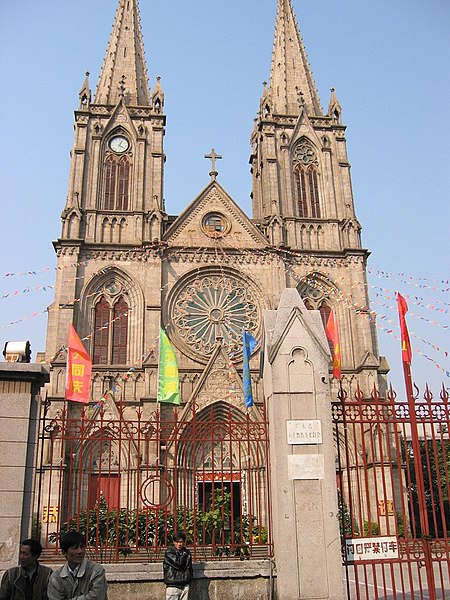Re: Re: reorganisation and destruction of irish catholic churches
Home › Forums › Ireland › reorganisation and destruction of irish catholic churches › Re: Re: reorganisation and destruction of irish catholic churches
The Cathedral of the Sacred Heart in Canton City, China

The Catholic cathedral in Canton was built between 1860 to 1890. This neo-Gothic granite structure designed by a French architect is an amazing feat of workmanship by Chinese craftsmen with little knowledge of this type of construction. These workers had also to bear the brunt of the local population’s displeasure. Indeed, far from bringing Western missionaries and the people of Canton to some understanding and respect for each other, the building deepened the mistrust and became the focus of bitter disputes and clashes.
The uncompromising attitude and political maneuvering of Bishop Guillemin in the pursuit of his dream of a magnificent Gothic cathedral did nothing to alleviate Chinese suspicion of missionaries’ collusion with Western expansionist plans. He repeatedly disregarded local fengshu i and used French political and military might to his advantage in claiming a site for his new church. His pick was as much a political as a religious statement. Indeed, the location he set sight upon was the grounds of the governor-general palace destroyed in December 1857 by Anglo-French forces. In 1879, the bishop’s obsession with church constructions in his vicariate was to an extent responsible for his recall to Europe by Rome. Guillemin’s immediate successors were unable to defuse the population’s resentment against missionaries, the converts, and the cathedral.
On the Chinese side, the governor and governor-general vacillated between orders from Beijing to accommodate missionaries and demands from the local gentry for punitive actions against these same foreigners. This anti-foreign local elite played a crucial role in venting the population anger against the cathedral as the most obvious and prominent symbol of foreign impingement in the city. In 1880, an angry mob threatened the unfinished building and destroyed Christian housing. The onset of the conflict with France over Annam further increased the tension and led to a widespread persecution of Christians in the province. To prevent another riot in Canton, the governor-general ordered missionaries to leave and confiscated the property of the cathedral. The situation did not quiet down until the end of the Sino-French war in June 1885.
In today Canton, missionaries are gone, anti-foreignism is at an all-time low, and Catholicism is striving. The resentment against the cathedral, known by the population as the Stone House ( shishi ), has disappeared. In a strange twist of history, the present provincial government has declared the building a valued cultural monument. At long last, instead of being a divisive symbol in the city skyline, the Canton cathedral has become a peaceful testimony of a common heritage proudly treasured by East and West.
